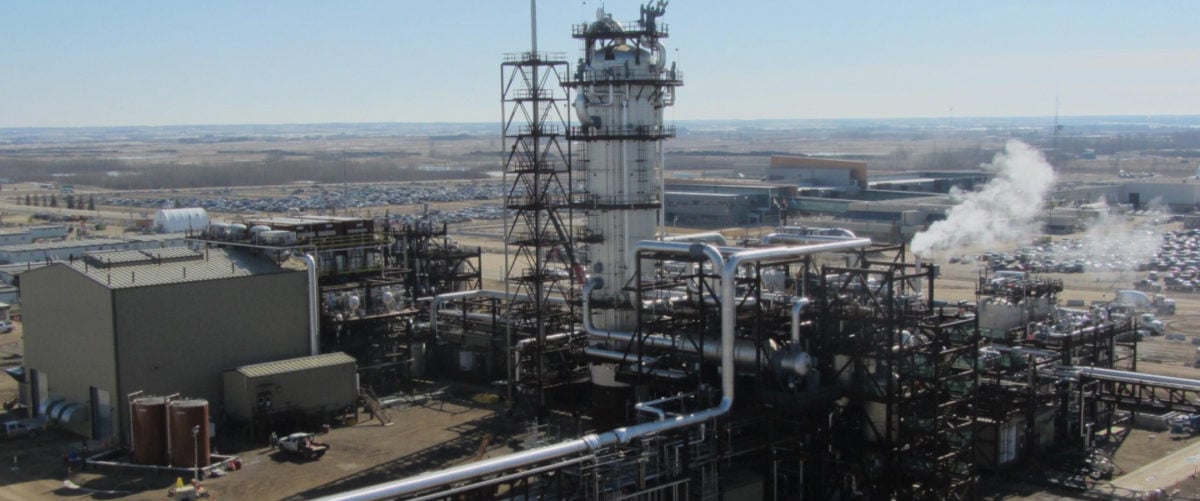Sorry, Fossil Fuel Industry. “Carbon Capture” Isn’t a Magic Climate Cure.
Published Apr 10, 2020

Carbon capture projects are slick schemes to make us think climate-warming emissions can be pulled from the sky. But reality shows it’s not so simple.
Updated and republished April 26, 2023.
It’s no secret that we need a radical change in the way we produce energy. But the fossil fuel industry is selling “fixes” to decision-makers in a blatant attempt to keep us locked into their failing model.
The most prominent one is called carbon capture and storage. Carbon capture technologies aim to get rid of carbon dioxide at the source, or even remove it from the atmosphere.
If that sounds too good to be true, that’s because it is. But there’s no mystery why carbon capture is so popular with the dirty energy giants: It lets them carry on with business as usual while pretending to do something meaningful to fight climate change.
What Is Carbon Capture and Does It Work?
With carbon capture and storage, fossil fuel companies claim they can capture CO2 either at the smokestack or in the atmosphere, transport it in pipelines, and inject it underground.
In every scenario, though, carbon capture faces huge technical, financial, and environmental barriers.
Despite optimistic projections and extensive government support over the past two decades, carbon capture projects remain obscenely expensive. Most projects have been shelved after delays and cost blowouts.
The only US carbon capture-equipped power plant ever completed cost several times what it would have cost to simply build comparable renewable energy capacity.
There’s a lot of green rhetoric about carbon capture plants, but they are in fact really bad for the climate. That’s because they have to burn additional fuel to power carbon capture equipment.
Food & Water Watch found that after accounting for methane emissions from fuel production, carbon capture can only reduce a fraction of climate pollution from electricity generation. And increasing fuel use would worsen the unjust air pollution and other burdens that fall disproportionately on vulnerable communities.
“Negative-Emissions” Technologies Promise Pie-in-the-Sky but Don’t Deliver
Beyond carbon capture-equipped power plants, other “negative-emissions” technologies promise to remove carbon from the atmosphere in the future. Those include combining carbon capture with biofuel production or directly capturing carbon from the atmosphere.
Biomass and biofuel facilities grow crops and burn them for fuel. When equipped with carbon capture, they are called “carbon negative,” because the crops or trees are supposed to sequester the CO2.
But this shady carbon math doesn’t factor in the energy-heavy agricultural inputs and land use trade-offs. Heavy use of biofuels could require up to 80% of what’s currently used as cropland, which could also threaten food security.
The “direct air capture” (DAC) approach uses large fans to capture CO2 from the atmosphere. Industry enthusiasts call this the ultimate “everyone wins” scenario. Sounds promising, right?
Except it doesn’t work in the real world. DAC is incredibly energy-intensive and expensive, in part because CO2 makes up only a small portion of our air. And if you power the technology with natural gas or coal, DAC could actually emit more CO2 than it captures.
What Happens to the Carbon After You “Capture” It?”
The problems get worse once you start trying to do something with the carbon you capture. It must be stored underground for centuries, a feat that hasn’t proven possible.
Most damningly, storage would depend on inherently leaky and dangerous technology like pipelines, underground gas storage, and high-pressure injection.
To dodge these problems, oil companies spend millions to hype “cool” potential uses for captured carbon, like making vodka. But right now, the only real use for captured carbon is enhanced oil recovery (EOR). EOR injects CO2 into oil reservoirs to drive the last dregs of oil to the surface.
In other words, the industry would use CO2 to extract more fossil fuels.
When EOR-produced oil is combusted it (obviously) increases carbon emissions, which defeats the whole point of storing it in the first place.
The Fossil Fuel Industry Loves Carbon Capture, and Some Political Leaders Are Pushing It, Too
Fossil fuel companies are desperately pushing for carbon capture, which is gaining buzz as a supposed win-win cure-all. Utilities and corporate interests embrace carbon capture because it would allow them to keep their profitable assets and business strategy intact, while falsely easing climate concerns.
In reality, carbon capture would lead fossil-fueled power plants to burn more fuel. And the climate consequences of producing this fuel would be disastrous.
Unfortunately, the government is creating powerful incentives to promote carbon capture. For instance, the Energy Department recently announced that it will provide $22 million for research “to achieve ‘breakthroughs’ in technology to capture carbon dioxide directly from that air.”
And even though there are no signs that carbon capture is effective, many lawmakers still highlight it as key to their climate plans.
For example, Pennsylvania lawmakers are pushing to designate carbon capture plants as a kind of renewable energy. Meanwhile, in New Mexico, investors are trying to use the promise of carbon capture to save a large coal plant. This plant might (and should) otherwise close due to the state’s climate regulations.
There is no future for the toxic fossil fuel industry, with or without carbon capture. Climate pollution like CO2 is the industry’s downfall, and there is no magic cure for that.
Instead of bailouts or gimmicky technology that doesn’t deliver, we must have public control of the oil and gas industries, as well as a rapid wind down of fossil fuels and build-out of renewable energy. That’s the ticket to ensure a stable pathway and just transition away from fossil fuels and towards real clean energy.
Your friends and family need to know: Carbon capture is a climate scam, not a climate solution!
Enjoyed this article?
Sign up for updates.
TO TOP


